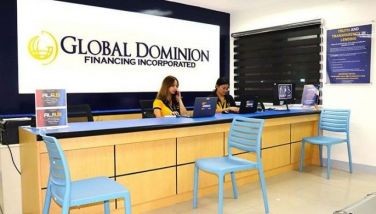Oracle Offers Software Solutions For All Types Of Business
August 3, 2004 | 12:00am
The distinction of being a company that makes software for large enterprises is starting to blur for Oracle Corporation as it begins its new fiscal year by adding small and medium enterprises (SMEs) among its key client portfolios.
Oracle’s fiscal year 2005 started June 1 and its marching order to all its offices worldwide, including its Philippine subsidiary, is to keep the company’s leadership position in the enterprise market while expanding to new territory that is the SME space. In both areas, Oracle is also to advance open source technologies, particularly the use of low-cost Intel servers for Linux applications.
Having identified their three leadership strategies, Oracle executives, without giving specific figures, are bullish about their current fiscal year. Last year, Oracle Corp.’s net income was up 16 percent to $2.7 billion while total revenue increased seven percent to $10.2 billion for the year with software revenue up 12 percent to $8.1 billion.
The long-time enterprise software giant began its aggressive foray in the SME market with the introduction last year of key products namely the Oracle E-Business Suite Special Edition (EBS SE), Oracle Database Standard Edition (SE) and the Oracle Database Standard Edition One (SE 1).
Oracle’s first Philippine customer for the EBS SE is M&H Corporation, the company behind Chinese food chain Hen Lin.
Yashi Kant, managing director of Oracle Philippines, said the EBS SE has done exceedingly well in the Asia Pacific because of its low price factor and the considerably less implementation time it requires. Kant added that in the last six months Oracle database entry-level solutions also won over customers from the mid-market, with the Standard Edition One at $149 per user becoming "a phenomenon that resulted in over 3,000 customers" worldwide.
"The SME market is becoming mature and sophisti-cated and is demanding tools that large enterprises use. We are seeing small businesses growing their need for appli-cations," Kant said.
Kant emphasized that Oracle’s mid-market solutions are not stripped down versions of their enterprise offerings. Oracle’s venture in the SME realm, Kant continued, is also not an indication of a saturated enterprise software market. In fact, the introduction of enterprise software and services such as the Oracle Grid, Oracle Database 10g, Oracle Application Server 10g, and Real Application Cluster (RAC) are largely credited for the best ever operating margin of 38 percent that the company experienced last year, he said.
Francis Ong, sales director for alliance and channels at the local Oracle subsidiary, pointed out that the IT needs of large enterprises won’t diminish, as they still need to stay competitive. "Large enterprises still need innovative (IT) products so the opportunities for us to sell in the enterprise space are still there. At the same time their need to reduce cost is higher than ever," Ong said.
If Oracle has a theme for its current fiscal year, it will be about system consolidation and cost reduction. Expect the company to make lots of pronouncements along these two areas, which are the very challenges that many customers are facing, Oracle executives said.
Today a lot of large and small companies are still struggling with multiple IT systems that they built over the years following a piecemeal approach to computerization. Oracle calls this the "spaghetti system" and its remedy for this is a business flow approach to automation to address issues related to system consolidation and cost reductions.
For big enterprises in particular, Oracle has started to preach its three technology solutions and strategies, namely, the Oracle Information Architecture (OIA), Oracle Grid Computing and the Oracle Customer Data Hub. These three concepts carry with them Oracle’s vision and approach to how companies should arrive at a consolidated IT infrastructure. All three discourage imple-menting multiple systems, which leads to data fragmentation.
"Oracle’s approach to its market has always been based on the effort to reduce complexity. We are continuously encouraging enterprises to move away from a complex IT architecture made up of disparate systems and multiple databases and servers. In the long run, these become too costly to maintain," said Kant. "We believe our single strength here is not managing complexity but reducing it in the enterprise."
Rey Paragas, senior manager for E-Business Solutions at Oracle Philippines, said companies’ consolidation efforts could be guided by OAI, which provides a way to measure the cost of current architectures and a path to consolidate applications, data and hardware infrastructure. "Through consolidation, the number of vendors in an enterprise’s architecture and consequently the wide variety of skills needed to support this structure are reduced," Paragas added.
Oracle’s challenge, however, doesn’t end with the removal of the spaghetti systems in big enterprises but also in trying to keep SMEs from having the same chaotic architecture as they grow big. For one, "you can’t do OIA in a day or even in a year," admitted Kant. The same is true for the Oracle Grid and the Oracle Data Hub. In all three, there are logical steps to be taken along the way, Kant said.
Oracle will also continue to count on Linux’s rise in the enterprise to drive adoption of Oracle solutions. In the country, Kant said Linux adoption interestingly surged last year more in the commercial sector followed only by academe and government.
Seeing that Linux adoption is taking a faster pace, Oracle Asia Pacific recently launched a series of Linux initiatives to drive the widespread adoption of Linux. Linux vendors Red Flag and Miracle, from China and Japan, respectively, have jointly developed in Oracle’s China Development Center the first Linux operating environment for businesses in Asia called Asianux. More recently, the company formed the new Linux Business Unit for Asia Pacific based in Singapore.
Oracle and Red Hat have also announced the launch of an Oracle-Red Hat Linux Enterprise Applications Porting (LEAP) center in Singapore to grow the ecosystem of independent software vendors (ISVs) and system integrators (Sis) in the region that deliver solutions on Linux. The LEAP center is the first significant Linux initiative in Singapore, and the first joint Oracle-Red Hat Linux solution center in the world.
All initiatives should help Oracle meet one of its ultimate goals this year, which is to identify and retain key customers. Kant said they want to build stronger customer loyalty by offering more value-added services and partnering with more third-party service providers.
To align its business objectives with that of its customers, Oracle is beefing up other aspects of its customer services that include training, technical support, consulting and even education. Early this year, Oracle opened the Oracle University Asia Pacific Call center in the country. The call center services the Oracle University, the group that provides courses and services to Oracle users.
Oracle’s fiscal year 2005 started June 1 and its marching order to all its offices worldwide, including its Philippine subsidiary, is to keep the company’s leadership position in the enterprise market while expanding to new territory that is the SME space. In both areas, Oracle is also to advance open source technologies, particularly the use of low-cost Intel servers for Linux applications.
Having identified their three leadership strategies, Oracle executives, without giving specific figures, are bullish about their current fiscal year. Last year, Oracle Corp.’s net income was up 16 percent to $2.7 billion while total revenue increased seven percent to $10.2 billion for the year with software revenue up 12 percent to $8.1 billion.
The long-time enterprise software giant began its aggressive foray in the SME market with the introduction last year of key products namely the Oracle E-Business Suite Special Edition (EBS SE), Oracle Database Standard Edition (SE) and the Oracle Database Standard Edition One (SE 1).
Oracle’s first Philippine customer for the EBS SE is M&H Corporation, the company behind Chinese food chain Hen Lin.
Yashi Kant, managing director of Oracle Philippines, said the EBS SE has done exceedingly well in the Asia Pacific because of its low price factor and the considerably less implementation time it requires. Kant added that in the last six months Oracle database entry-level solutions also won over customers from the mid-market, with the Standard Edition One at $149 per user becoming "a phenomenon that resulted in over 3,000 customers" worldwide.
"The SME market is becoming mature and sophisti-cated and is demanding tools that large enterprises use. We are seeing small businesses growing their need for appli-cations," Kant said.
Kant emphasized that Oracle’s mid-market solutions are not stripped down versions of their enterprise offerings. Oracle’s venture in the SME realm, Kant continued, is also not an indication of a saturated enterprise software market. In fact, the introduction of enterprise software and services such as the Oracle Grid, Oracle Database 10g, Oracle Application Server 10g, and Real Application Cluster (RAC) are largely credited for the best ever operating margin of 38 percent that the company experienced last year, he said.
Francis Ong, sales director for alliance and channels at the local Oracle subsidiary, pointed out that the IT needs of large enterprises won’t diminish, as they still need to stay competitive. "Large enterprises still need innovative (IT) products so the opportunities for us to sell in the enterprise space are still there. At the same time their need to reduce cost is higher than ever," Ong said.
Today a lot of large and small companies are still struggling with multiple IT systems that they built over the years following a piecemeal approach to computerization. Oracle calls this the "spaghetti system" and its remedy for this is a business flow approach to automation to address issues related to system consolidation and cost reductions.
For big enterprises in particular, Oracle has started to preach its three technology solutions and strategies, namely, the Oracle Information Architecture (OIA), Oracle Grid Computing and the Oracle Customer Data Hub. These three concepts carry with them Oracle’s vision and approach to how companies should arrive at a consolidated IT infrastructure. All three discourage imple-menting multiple systems, which leads to data fragmentation.
"Oracle’s approach to its market has always been based on the effort to reduce complexity. We are continuously encouraging enterprises to move away from a complex IT architecture made up of disparate systems and multiple databases and servers. In the long run, these become too costly to maintain," said Kant. "We believe our single strength here is not managing complexity but reducing it in the enterprise."
Rey Paragas, senior manager for E-Business Solutions at Oracle Philippines, said companies’ consolidation efforts could be guided by OAI, which provides a way to measure the cost of current architectures and a path to consolidate applications, data and hardware infrastructure. "Through consolidation, the number of vendors in an enterprise’s architecture and consequently the wide variety of skills needed to support this structure are reduced," Paragas added.
Oracle’s challenge, however, doesn’t end with the removal of the spaghetti systems in big enterprises but also in trying to keep SMEs from having the same chaotic architecture as they grow big. For one, "you can’t do OIA in a day or even in a year," admitted Kant. The same is true for the Oracle Grid and the Oracle Data Hub. In all three, there are logical steps to be taken along the way, Kant said.
Seeing that Linux adoption is taking a faster pace, Oracle Asia Pacific recently launched a series of Linux initiatives to drive the widespread adoption of Linux. Linux vendors Red Flag and Miracle, from China and Japan, respectively, have jointly developed in Oracle’s China Development Center the first Linux operating environment for businesses in Asia called Asianux. More recently, the company formed the new Linux Business Unit for Asia Pacific based in Singapore.
Oracle and Red Hat have also announced the launch of an Oracle-Red Hat Linux Enterprise Applications Porting (LEAP) center in Singapore to grow the ecosystem of independent software vendors (ISVs) and system integrators (Sis) in the region that deliver solutions on Linux. The LEAP center is the first significant Linux initiative in Singapore, and the first joint Oracle-Red Hat Linux solution center in the world.
To align its business objectives with that of its customers, Oracle is beefing up other aspects of its customer services that include training, technical support, consulting and even education. Early this year, Oracle opened the Oracle University Asia Pacific Call center in the country. The call center services the Oracle University, the group that provides courses and services to Oracle users.
BrandSpace Articles
<
>
- Latest
Latest
Latest
November 12, 2024 - 9:00am
November 12, 2024 - 9:00am
November 11, 2024 - 1:43pm
By EC Toledo | November 11, 2024 - 1:43pm
November 6, 2024 - 7:16pm
November 6, 2024 - 7:16pm
November 6, 2024 - 4:50pm
November 6, 2024 - 4:50pm
November 4, 2024 - 9:12am
November 4, 2024 - 9:12am
November 1, 2024 - 9:00am
By Aian Guanzon | November 1, 2024 - 9:00am
Recommended





























